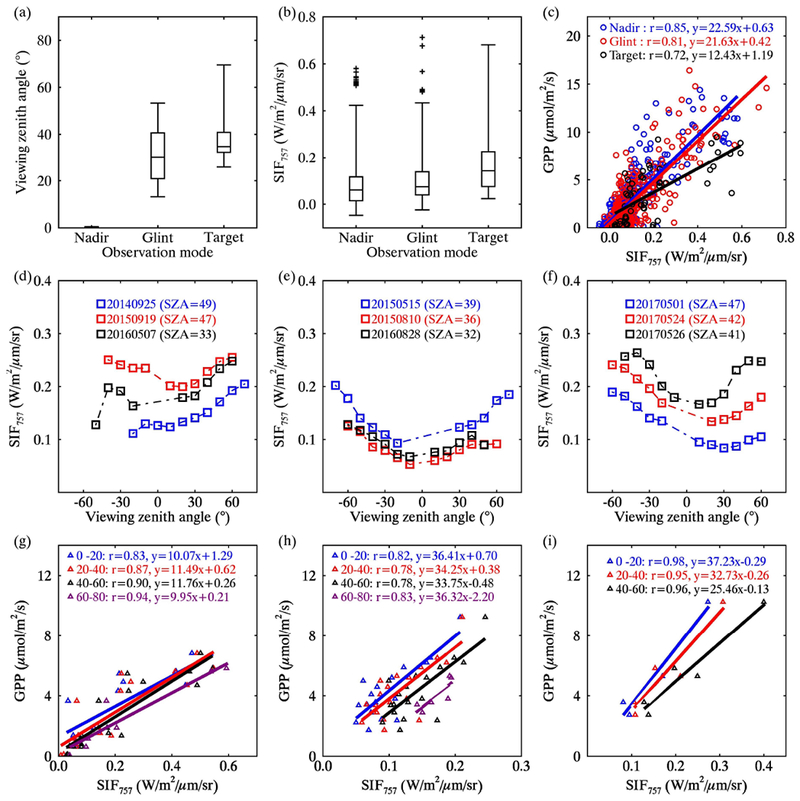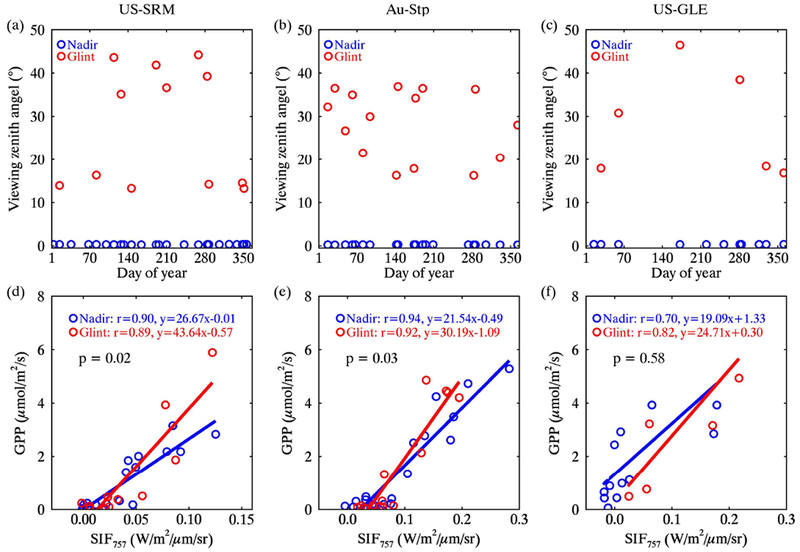It is important to understand how sun-sensor geometry affects satellite sun -induced fluorescence (SIF) in order to take full advantage of these measurements, particularly given their close relationship with gross primary production (GPP). A recent paper by Li et al. (2018) (hereafter L2018) presented results on the relationship between OCO-2 SIF and GPP from 64 flux sites. Similar to Sun et al. (2017), this study suggested a nearly universal rather than biome-specific SIF-GPP relationship across biomes though a higher slope was found for C4 plants. Their results are distinct from previous studies (Guanter et al., 2012; Zhang et al., 2016). We argue that the universal relationship may be biased by not separating SIF data from three observation modes that have different sensor view zenith angles.
OCO-2 products have three observation modes nadir, the satellite points the instrument to the local nadir with zero viewing zenith angles (VZAs); glint, with varying VZA; and target, the observation will lock its view onto specific ground validation sites. L2018 used all three modes in the OCO-2 product which have different viewing zenith angles (VZA) and hence different ranges of SIF (Figure 1a, b). Similar to canopy reflectance, there are noticeable angular variations of SIF (van der Tol et al., 2009; Liu et al., 2015). This variation has effect on the SIF-GPP relationship (He et al., 2017). Therefore, this effect should be taken into account when we use SIF data from OCO-2 across sites 2 (Sun et al., 2018).
Figure 1.

The distributions of (a) viewing zenith angle (VZA) and (b) SIF from OCO-2, and (c) the relationships between GPP and OCO-2 SIF from 82 tower sites in different modes (nadir, blue; glint, red; target, black). The SIF at different VZA for (d) US-PFa (mixed forest), (e) AU-How (woody savannas), and (f) FI-Hyy (evergreen needleleaf forest) sites. The relationships between SIF and GPP under different VZA for (g) US-PFa, (h) AU-How, and (i) FI-Hyy sites.
L2018 suggests that there are no significant differences between the slopes of SIF-GPP relationship derived from observations with the nadir and other modes. With more sites (82), however, we observed significant (p < 0.001) differences in the slopes (Figure 1c). This is attributed to the different viewing geometries of the various modes (Frankenberg et al., 2014). To display the bi-directionality of SIF, we show SIF at different VZA in the solar principal plane at three flux sites where there are continuous observations with different VZAs made in the target mode. A clear bowl shape of SIF can be observed from the backward to forward scattering directions (Figure 1d-f). This is consistent with both ground- and model-based results (van der Tol et al., 2009; Liu et al., 2015). Directional variations of SIF were also observed from GOME-2 and GOSAT measurements (Guanter et al., 2012; Köhler et al., 2018).
Sun et al. (2017) performed a regression using nadir mode OCO-2 and flux tower data to derive a SIF-GPP relationship, forcing a linear fit through the origin. They reported that a universal SIF-GPP relationship may be foreseen across biomes. In contrast, L2018 performed a regression fit with a non-zero intercept. Therefore, the difference in slopes as well as intercepts should be considered when evaluating the variations in the SIF-GPP relationship across biomes._In Figure 1(g)-(i), the slopes are similar among different VZAs for the three sites, but the GPP-SIF relationships are obviously different because of the different intercepts. If a regression without an intercept is applied, the slopes vary significantly at the three sites.
We also find that there is no significant difference in slopes between nadir and glint modes for all data grouped together, but whether the conclusion holds for individual sites is still unknown. For the 64 flux sites in L2018, some sites were mainly collected with nadir observations and the others mainly with glint observations. Several sites have similar number of both nadir or glint observations, where the glint mode has varying east-west offsets relative to nadir (Sun et al., 2018). We selected three sites that have a good mix of both nadir and glint observations as well as GPP data to compare the SIF-GPP relationships for both modes. It shows that VZAs in the glint mode vary with date and location; the VZAs for nadir mode are nearly zero for all observations (Figure 2a-c). This results in a varying SIF-GPP relationship derived from glint mode observations even at a single site due to variations in the VZA. We found that the derived SIF-GPP slopes between nadir and glint modes are significantly different (p <0.05) for the US-SRM and AU-Stp sites (Figure 2d-e). Although there are not significant differences at the US-GLE site, the slope of the SIF-GPP relationship for the glint mode is still 1.3 times higher than that from the nadir mode (Figure 2f).
Figure 2.

The viewing zenith angle of nadir (blue circles) and glint modes (red circles) for (a) US-SRM (woody savannas), (b) AU-Stp (grass), and (c) US-GLE (evergreen needleleaf forest) sites. The relationships between OCO-2 SIF and GPP for nadir (blue circles) and glint modes (red circles) at (d) US-SRM, (e) AU-Stp, and (f) US-GLE sites. The slopes were compared using two-tailed T test.
In conclusion, it is important to consider the bi-directionality of SIF when using OCO-2 SIF data to evaluate the SIF-GPP relationship. One way to avoid the directional variations of SIF is to use only the nadir mode as it provides constant view zenith angle observations over time (Sun et al., 2018). Whether there exists a universal or nearly universal relationship between GPP and SIF across biomes is still an open question that needs further research.
Acknowledgement:
This research was supported by General Program of NSFC (41671421). This work used eddy covariance flux data from the FLUXNET. The OCO-2 SIF (v8r) used was downloaded from NASA Goddard Earth Science.
Reference:
- Frankenberg C, O’Dell C, Berry J, Guanter L, Joiner J, Koehler P, et al. (2014). Prospects for chlorophyll fluorescence remote sensing from the Orbiting Carbon Observatory-2. Remote Sensing of Environment, 147, 1–12. 10.1016/j.rse.2014.02.007 [DOI] [Google Scholar]
- Guanter L, Frankenberg C, Dudhia A, Lewis PE, Gómez-Dans J, Kuze A, et al. (2012). Retrieval and global assessment of terrestrial chlorophyll fluorescence from GOSAT space measurements. Remote Sensing of Environment, 121, 236–251. 10.1016/j.rse.2012.02.006 [DOI] [Google Scholar]
- He L, Chen JM, Liu J, Mo G, & Joiner J (2017). Angular normalization of GOME-2 Sun-induced chlorophyll fluorescence observation as a better proxy of vegetation productivity. Geophysical Research Letters, 44, 5691–5699. 10.1002/2017GL073708 [DOI] [Google Scholar]
- Köhler P, Guanter L, Kobayashi H, Walther S, & Yang W (2018). Assessing the potential of sun-induced fluorescence and the canopy scattering coefficient to track large-scale vegetation dynamics in Amazon forests. Remote Sensing of Environment, 204, 769–785. 10.1016/j.rse.2017.09.025 [DOI] [Google Scholar]
- Li X, Xiao J, He B, Arain MA, Beringer J, Desai AR, et al. (2018). Solar-induced chlorophyll fluorescence is strongly correlated with terrestrial photosynthesis for a wide variety of biomes: First global analysis based on OCO-2 and flux tower observations. Global Change Biology, 1–9. http://doi.org/10.llll/gcb.14297 [DOI] [PubMed] [Google Scholar]
- Liu L, Liu X, Wang Z, & Zhang B (2015). Measurement and Analysis of Bidirectional SIF Emissions in Wheat Canopies. IEEE Transactions on Geoscience & Remote Sensing, 54, 2640–2651. 10.1109/TGRS.2015.2504089 [DOI] [Google Scholar]
- Sun Y, Frankenberg C, Jung M, Joiner J, Guanter L, Köhler P, & Magney T (2018). Overview of Solar-Induced chlorophyll Fluorescence (SIF) from the Orbiting Carbon Observatory-2: Retrieval, cross-mission comparison, and global monitoring for GPP. Remote Sensing of Environment, 209, 808–823. 10.1016/j.rse.2018.02.016 [DOI] [Google Scholar]
- Sun Y, Frankenberg C, Wood JD, Schimel DS, Jung M, Guanter L, et al. (2017). OCO-2 advances photosynthesis observation from space via solar-induced chlorophyll fluorescence. Science, 358, eaam5747 10.1126/science.aam5747 [DOI] [PubMed] [Google Scholar]
- van der Tol C, Verhoef W, Timmermans J, Verhoef A, & Su Z (2009). An integrated model of soil-canopy spectral radiances, photosynthesis, fluorescence, temperature and energy balance. Biogeosciences, 6, 3109–3129. 10.5194/bg-6-3109-2009 [DOI] [Google Scholar]
- Zhang Y, Xiao X, Jin C, Dong J, Zhou S, Wagle P, et al. (2016). Consistency between sun-induced chlorophyll fluorescence and gross primary production of vegetation in North America. Remote Sensing of Environment, 183, 154–169. 10.1016/j.rse.2016.05.015 [DOI] [Google Scholar]


